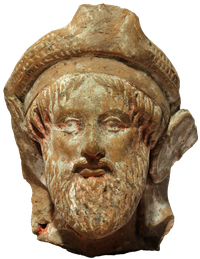Head of a bearded symposiast with wreath and bandage
 |
Head of a bearded symposiast with wreath and bandage, Inv. T I-17 Fully sculpted, front side out of the mould; back rounded, not finished, smoothed. Careful reworking with the modelling wood, especially on the hair strands over the temples and ears. Light grey-brown (7.5YR 7/3) clay with fine inclusions. Abundant white engobe. Painting: Light red on the neck, in the hair and in the corners of the eyes as well as around the mouth; black on the beard, pink on the rosette and bandage. Provenance: Unknown. State of preservation: Head with base of neck, wreath with palmette base, parts of the left rosette and the bandage. Centre rosette and decorative elements of the right side lost. Dimensions: H: 9,7 cm; W: 7,9 cm; D: 6,7 cm. References: W. Wamser-Krasznai, Studien zu den Typen der Tarentiner Symposiasten (Diss. Justus- Liebig- Universität Gießen 2003) URL: http://geb.uni-giessen.de/geb/volltexte/2003/1184, 100. 126. 137. 175 figs. 38 and 38 a. b; W. Zschietzschmann, Die Antikensammlungen der Universität, Gießener Hochschulblätter 5, 1957, no. 2 fig. 5.; W. Wamser-Krasznai, Für Götter gelagert (Budapest 2013), 93-96. |
Description: The head is decorated with a bandage surmounted by a dotted bead wreath. The base of the palmette is slightly shifted to the left side. A former four-petalled rosette sits above the left ear. Short straight strands of hair emerge from under the bandage and diverge in a pincer-like pattern in the middle. Longer lateral strands cover the base of the beard composed of flame-like strands. The evenly streaked moustache tapers into ornamentally curved tips (only visible on the right side). The forehead and nose merge without a break. Fine modelling enlivens the cheeks. The eyes lie under high orbitals and sharply defined brows; they are framed by narrow, arched upper lids and full lower lids blending softly into the cheeks. The head is slightly tilted to its left side, the neck curved accordingly.
Commentary: The bearded head adorned with wreath and bandage probably belonged to a symposiast who wore a mantle with a dot pattern (bostrychoi - provided with relief dots[1]) and rested on a kline decorated with a pillar relief[2]. It is also conceivable, however, that he was resting or riding on a living creature, e.g. as a 'ketos rider'[3]. The original height of the statuette can be estimated at about 40 cm.
A special feature is the rosette, which is composed of only four petals[4]. As a rule, the rosettes are five- sometimes six-petalled; exceptionally, they consist of eight petals.
Apart from the headdress, the specifically tarentine characteristics include the width of the face at the level of the eyes and the increase in the volume of hair above the ears[5].
With its three-dimensional layout, the short hairstyle, the flat eyeballs and ribbon-like narrow, slightly curved eyelids, the head resembles a clay relief from Taranto created during the time of the advanced Classical period, in the so-called Rich Style[6].
Determination: End of the 5th century BC, from Taranto
 |
 |
 |
|---|
[1] C. E. Vafopoulou-Richardson, Greek Terracottas Ashmolean Museum Oxford (1981) 25f. no. 24; U. Hübinger – M. Menninger, Terrakotten der Westgriechen im Akademischen Kunstmuseum der Universität Bonn (Rahden/Westf. 2007) 106 no. 28.
[2] W. Wamser-Krasznai, Studien zu den Typen der Tarentiner Symposiasten (Diss. Justus- Liebig- Universität Gießen 2003) URL: http://geb.uni-giessen.de/geb/volltexte/2003/1184, 173 no. 442. 443 fig. 69.70; B. Neutsch, Der Heros auf der Kline, RM 68, 1961, 153f. pl. 62, 1. 63. 65; M. Borriello, L’Apulia. Taranto, in: St. De Caro – M. Borriello (Hrsg.), La Magna Grecia nelle collezioni del Museo Archeologico di Napoli (Neapel 1996) 101 no. 9.27.
[3] C. Iacobone, Le stipi votive di Taranto (Rom 1988) 97 pl. 91b; ebenso E. Lippolis – S. Garaffo – M. Nafissi, Taranto. Culti Greci in Occidente I (Tarent1995) 53, Taf. 11, 5; W. Wamser-Krasznai ibid., 160 cat.-no. 265 fig. 37.
[4] H. Herdejürgen, Die Tarentinischen Terrakotten des 6. bis 4. Jahrhunderts v. Chr. im Antikenmuseum Basel (Basel 1971) 51 pl. 9, 35; W. Wamser-Krasznai, Studien zu den Typen der Tarentiner Symposiasten (Diss. Justus- Liebig- Universität Gießen 2003) URL: http://geb.uni-giessen.de/geb/volltexte/2003/1184, 161 no. 272 fig. 40; Wamser-Krasznai ibid., cat. 456 fig. 36; Triest 4129, N. Poli, Collezione Tarantina del Civico Museo di Storia ed Arte. Coroplastica arcaica e classica (Triest 2010) 241 no. 378 pl. 287.
[5] W. Wamser-Krasznai ibid, 66 cat. 244 fig. 34 and cat. 252 fig. 35; U. Hübinger – M. Menninger, Terrakotten der Westgriechen im Akademischen Kunstmuseum der Universität Bonn (Rahden/Westf. 2007) 131 no. 56 or S. 137 no. 64; E. Schmidt, Katalog der antiken Terrakotten 1, Martin-von-Wagner-Museum der Universität Würzburg (Mainz 1994) 129 f. no. 199 Taf. 37.
[6] Relieffragment in Berlin, O. Pilz, Dionysos auf einem Tonrelief klassischer Zeit in Berlin? AM 120, 2005, 269-283, pls. 48-51, 270-272 pls. 48 f.; E. Langlotz, Die Kunst der Westgriechen (München 1963) 86, fig. 125 a.
